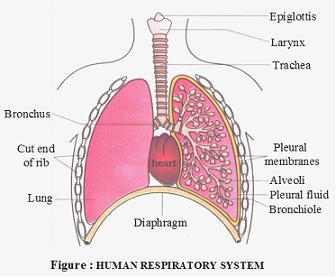Chapter : 2. Respiration
Mammalian Respiratory System
Mammalian Respiratory System
The mammalian respiratory system consists of nasal cavity, pharynx, larynx, trachea, bronchi, bronchioles and alveoli.-
The mammalian respiratory system consists of nasal cavity, pharynx, larynx, trachea, bronchi, bronchioles and alveoli.
Nostril :
It is also called external nares.
Nasal Chamber :
Nasal septum divides nasal cavity into two nasal chamber by the nasal septum.
Internal nares :
There are posterior opening of nasal chambers that leads into pharynx.
Pharynx :
The pharynx provides passage to both air and food.
Laryngopharynx :
It is the lower part of pharynx and has a slit like aperature called glottis, which can be closed by a leaf like bilobed cartilage epiglottis, during swallowing of food bolus.
Larynx :
It is also called voice box or adam's apple or pomas adami.
Vocal cord :
In larynx, 2 pairs of vocal cord is found outer pair is false vocal cord whereas, inner pair is true vocal cord when air is forced through the larynx it cause vibration of true vocal cords and sound is produced.
Trachea (Wind pipe) :
It is long, tubular structure which runs downward through the neck in front of oesophagus. It is supported by cartilage to prevent collapse
Primary bronchi :
These are one pair of small thin walled tubular structure formed by the division of trachea. It further divides and end at alveoli.
Lungs :
lungs are present in thoracic cavity on either side of heart. covered by pleural membrane.

The mammalian respiratory system consists of nasal cavity, pharynx, larynx, trachea, bronchi, bronchioles and alveoli.-
The mammalian respiratory system consists of nasal cavity, pharynx, larynx, trachea, bronchi, bronchioles and alveoli.
Nostril :
It is also called external nares.
Nasal Chamber :
Nasal septum divides nasal cavity into two nasal chamber by the nasal septum.
Internal nares :
There are posterior opening of nasal chambers that leads into pharynx.
Pharynx :
The pharynx provides passage to both air and food.
Laryngopharynx :
It is the lower part of pharynx and has a slit like aperature called glottis, which can be closed by a leaf like bilobed cartilage epiglottis, during swallowing of food bolus.
Larynx :
It is also called voice box or adam's apple or pomas adami.
Vocal cord :
In larynx, 2 pairs of vocal cord is found outer pair is false vocal cord whereas, inner pair is true vocal cord when air is forced through the larynx it cause vibration of true vocal cords and sound is produced.
Trachea (Wind pipe) :
It is long, tubular structure which runs downward through the neck in front of oesophagus. It is supported by cartilage to prevent collapse
Primary bronchi :
These are one pair of small thin walled tubular structure formed by the division of trachea. It further divides and end at alveoli.
Lungs :
lungs are present in thoracic cavity on either side of heart. covered by pleural membrane.

Trending Articles & Blogs
- Physics Tutor, Math Tutor Improve Your Child’s Knowledge
- How to Get Maximum Marks in Examination Preparation Strategy by Dr. Mukesh Shrimali
- 5 Important Tips To Personal Development Apply In Your Daily Life
- Breaking the Barriers Between High School and Higher Education
- 14 Vocational courses after class 12th
- Tips to Get Maximum Marks in Physics Examination
- Get Full Marks in Biology Class 12 CBSE
Download Old Sample Papers For Class X & XII
Download Practical Solutions of Chemistry and Physics for Class 12 with Solutions
Recent Questions Asked
- Newton’s laws of motion asked by Dr. Mukesh Shrimali
- Process of nutrition in Amoeba asked by Rajiv Sharma
- Importance of studying physics subject in school after 10th asked by Rajiv
- Refraction Through Prism in Different Medium asked by Kirti Sharma
- Ratio and Proportion Question asked by Education Desk
- Explain all the 12 tenses with example asked by Qwerty
- Refraction Through Prism in Different Medium asked by Seema Shrimali